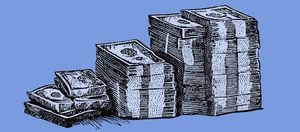What to Do When You Need a Disaster Loan
6 min. read
Updated October 27, 2023
When disaster strikes in your area and your business is affected, what’s next? For many small businesses, the future can be extremely uncertain.
During the process of rebuilding, most small business owners will ask themselves if it’s time to apply for a disaster loan, or if that is a viable option for them. Let’s go over some of the possibilities related to applying for a disaster loan.
First of all, am I eligible for a disaster loan?
If you’re in the United States, you’re going to be dealing with the Small Business Administration when applying for a disaster loan. The process is approachable (I will go into more detail below) and has a relatively short turn around, but the SBA does have loan requirements for eligibility.
Applicants need to have a reasonable credit history, a demonstrated ability to repay the loan, and for most disaster loans, the SBA requires that you back the loan with collateral (including real estate) to the extent that is possible. To give you an idea of success rates, of those who were eligible, 42 percent of applicants during Superstorm Sandy received the loans that they applied for.
Keep in mind that there is some debate that taking out a loan during times of crisis can ultimately be counter-productive by increasing your debt over the long term. As the business owner you will be personally guaranteeing repayment, so take a look at your credit and existing debt before accepting a loan.
Okay. But what constitutes a disaster?
Federal regulations in the U.S. define a scope of disasters or emergencies ranging from the natural (hurricane or mudslide) to the human made (such as civil unrest in Ferguson, MO or a factory explosion), with broad legal definitions. In addition to assisting businesses in recovery, the SBA does provide home and personal property loans.
If you are located in a legally declared disaster area and your business or private nonprofit has been affected, the SBA says that you may apply for a loan. It can provide assistance in up to two million dollars, as a total of both physical damage and economic injury loans, which you can apply for at the same time.
Types of EIDL loans
Let’s take a look at the specific types of disaster loans provided by the SBA:
Economic Injury Disaster Loans (EIDLs)
This type of loan is unrelated to physical damage; this is about the cost of being closed and losing sales. EIDLs are intended to help you meet the financial obligations that you may now suddenly be unable to pay for. In addition to small businesses and nonprofits, agricultural cooperatives can qualify for these types of loans.
Physical Disaster Loan
Physical disaster loans help you replace what has been literally destroyed or damaged by a disaster. The use of proceeds that the SBA lists for this funding is as follows:
- Real property
- Machinery
- Equipment
- Fixtures
- Inventory
- Leasehold improvements
The SBA may also provide you with additional funding of up to 20 percent of the total value of damage, to be put toward preventing future disaster damage.
Military Reservists Economic Injury Loans (MREIDL)
This is a very niche group of businesses who may be adversely affected when a key employee who is a military reservist is called into active military duty. Details here.
Applying for the loan
This part is fairly straightforward. There is some pertinent information that you’ll need to have on hand, including personal and business financial records, and your registration number from FEMA, the Federal Emergency Management Agency. You can then apply online here.
You will of course want to apply before the deadline; deadlines are set per declared disaster and you can find details for each here. Afterward, the official target for turn-around time on processing applications is 21 days, but in the past, the sheer volume of applicants has caused it to be more than twice that time.
Tips to prepare for possible disasters
Here are a few internationally applicable suggestions that will make disaster recovery easier.
1. Review your insurance coverage
The National Association of Insurance Commissioners suggests that you have property, liability, and business interruption insurance for your business. While this association is in the U.S., this is practical advice for every business.
Make note of the equipment, buildings, and assets in your business; those that if lost absolutely need to be replaced for business as usual to continue. Are those items insured? If your business had to close for an extended period of time (for example, due to flooding), does your insurance cover lost earnings or payroll during that time?
This can be critical information. According to the National Flood Insurance Program, the average business claim on flood insurance from 2008 to 2012 was $87,000.
2. Know your finances and keep backup records
Make sure you’re keeping track of your business and personal finances. Credit cards, debts, bill payments and more will all be relevant during the recovery and loan application process.
And as a college professor once told me: Data doesn’t exist unless it exists in at least two places. That means, if you’ve got all of your business financials on your laptop, that is great. If they are only on said laptop, which then is destroyed in a flood or fire, you will find yourself in a nightmare scenario of paperwork to get an insurance pay out or disaster loan for your business. Always have backups!
3. Have a continuity plan
Simply put, when it comes to disaster planning, think it through. Go through the utilities you depend on every day. Do you have a secondary option for electricity, water, or other supplies your business depends on?
Depending on the type of disaster, different things may become unusable. Make sure you’ve considered what you plan to do should critical components of your operation be destroyed. Ready.gov is a good resource with step-by-step tips for building a business continuity plan in case of emergencies.
What if things were not insured?
You might have let insurance lapse on an important piece of equipment, or your credit might be limited. It happens. If things are looking really grim, while this may not be the best option for everyone, according to the SBA site, they can refinance your mortgage.
“The SBA can refinance all or part of a previous mortgage in some cases when the applicant does not have credit available elsewhere, has suffered uninsured damage (40 percent or more of the property value), and intends to repair the damage,” is noted on their website.
Disaster recovery outside of the U.S.
- The Canadian government has its own federal loan programs in the event of a disaster. You can find details here.
- The European Union created the EU Solidarity Fund in 2002 specifically to respond to natural disaster-afflicted areas in Europe.
- USAID has a “How to Help” list of organizations leading international relief efforts for those who want to contribute to the recovery of large-scale disasters such as the 2011 devastating earthquake and tsunami in Japan.
Resiliency is the name of the game
In light of recent U.S. national disasters such as Superstorm Sandy and Hurricane Katrina, many people want to be better prepared. New York City began a business competition called Rise NYC, designed to promote better disaster preparedness by leveraging a hefty cash prize to the winning business, and all businesses gained plenty of publicity. Facebook now has a feature allowing people to connect more easily with friends and loved ones during the chaos of disasters. Cities are getting creative about making preventative solutions and harnessing technology to better support our infrastructure and citizens in times of disaster.









